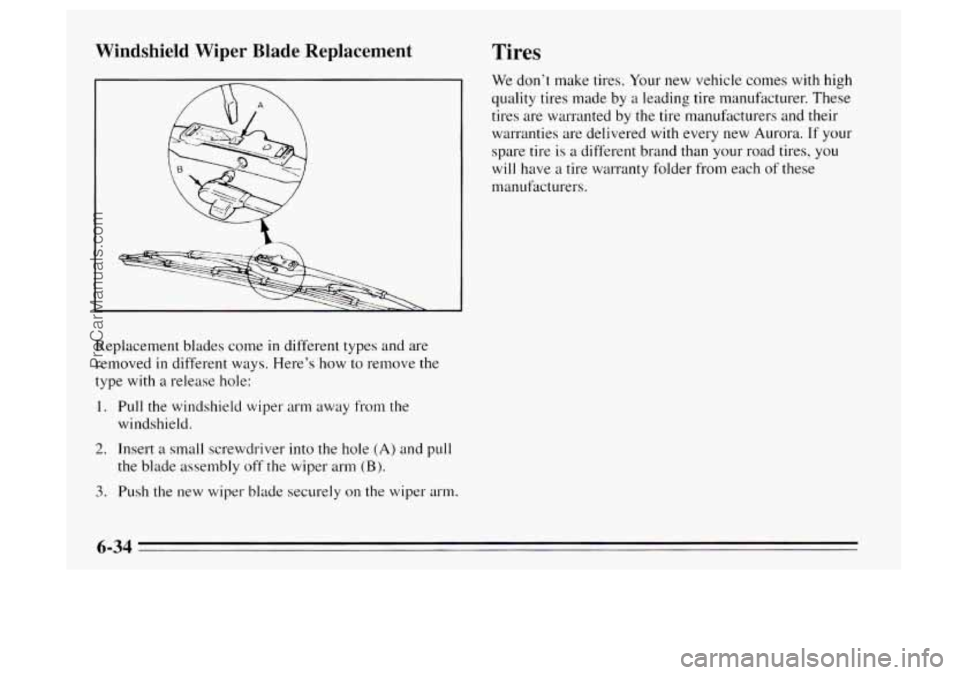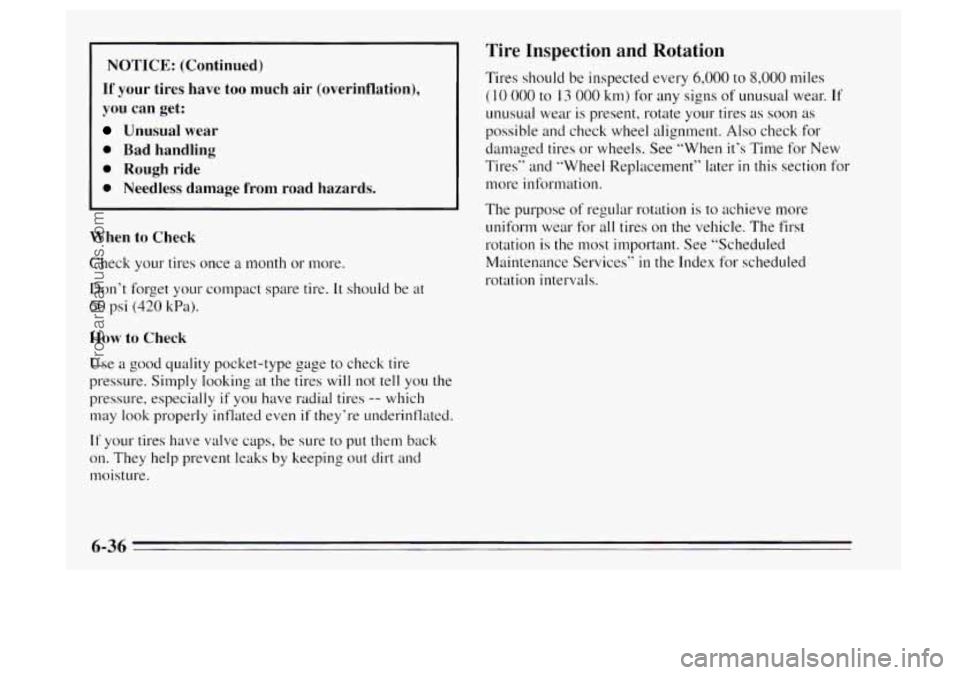tire type OLDSMOBILE AURORA 1995 Owners Manual
[x] Cancel search | Manufacturer: OLDSMOBILE, Model Year: 1995, Model line: AURORA, Model: OLDSMOBILE AURORA 1995Pages: 372, PDF Size: 19.14 MB
Page 177 of 372

0 Check your mirrors, glance over your shoulder, and
start your left lane change signal before moving out
of the right lane
to pass. When you are far enough
ahead of
the passed vehicle to see its front in your
inside mirror, activate your right lane change signal
and move back into the right lane. (Remember that
your right outside mirror is convex. The vehicle you
just passed
may seem to be farther away from you
than it really is.)
0 Try not to pass more than one vehicle at a time on
two-lane roads. Reconsider before passing the
next
vehicle.
Don’t overtake a slowly moving vehicle too rapidly.
Even though the brake lights are
not flashing, it may
be slowing down or starting to turn.
0 If you’re being passed, make it easy for the
following driver to get ahead
of you. Perhaps you
can ease a little to the right.
Loss of Control
Let’s review what driving experts say about what
happens when
the three control systems (brakes, steering
and acceleration) don‘t have enough friction where the
tires meet the road to do what the driver has asked.
In any emergency, don’t give up. Keep trying to steer
and constantly seek an escape route or area
of less
danger.
Skidding
In a skid, a driver can lose control of the vehicle.
Defensive drivers avoid most skids by taking reasonable
care suited to existing conditions, and by not
“overdriving” those conditions. But skids are always
possible.
The three types
of skids correspond to your Aurora‘s
three control systems.
In the braking skid your wheels
aren’t rolling.
In the steering or cornering skid, too
much speed or steering in a curve causes tires to slip and
lose cornering force. And in the acceleration skid too
much throttle causes
the driving wheels to spin.
A cornering skid is best handled by easing your foot off
the accelerator pedal.
Remember:
Any traction control system helps avoid
only the acceleration skid.
4-13
ProCarManuals.com
Page 208 of 372

Towing Your Vehicle
I
Try to have a GM retailer or a professional towing
service tow your Aurora. The usual towing equipment
is:
A. Sling-type tow truck
B. Wheel-lift tow truck
C. Car carrier
If your vehicle has been changed or modified since it
was factory-new
by adding aftermarket items like fog
lamps, aero skirting, or special tires and wheels, these
instructions and illustrations may
not be correct.
Before you do anything, turn
on the hazard warning
flashers.
When
you call, tell the towing service:
0
0
0
e
0
That your vehicle can only be towed with certain
equipment, as described later
in this section.
That your vehicle has front-wheel drive.
The make, model and year of your vehicle.
Whether you can still n~ove the shift lever.
If there was an accident, what was damaged.
When the towing service arrives, let the tow operator
know that this manual contains detailed towing
instructions and illustrations. The operator may want to
see them.
5-8
ProCarManuals.com
Page 264 of 372

Windshield Wiper Blade Replacement
I
Replacement blades come in different types and are
removed
in different ways. Here’s how to remove the
type with
a release hole:
1. Pull the windshield wiper arm away from the
windshield.
2. Insert a small screwdriver into the hole (A) and pull
the blade assembly off the wiper arm (B).
3. Push the new wiper blade securely on the wiper arm.
Tires
We don’t make tires. Your new vehicle comes with high
quality tires made by
a leading tire manufacturer. These
tires are warranted by the tire manufacturers and their
warranties are delivered with every new Aurora.
If your
spare tire is a different brand than your road tires,
you
will have a tire warranty folder from each of these
manufacturers.
6-34
ProCarManuals.com
Page 266 of 372

NOTICE: (Continued)
If your tires have
too much air (overinflation),
you can get:
Unusual wear
0 Bad handling
0 Rough ride
0 Needless damage from road hazards.
When to Check
Check your tires once a month or more,
Don’t forget your compact spare tire.
It should be at
60 psi (420 kPa).
Use a good quality pocket-type gage to check tire
pressure. Simply looking
at the tires will not tell you the
pressure, especially
if you have radial tires -- which
may look properly inflated even
if they’re underinflated.
If your tires have valve caps, be sure to put them back
on. They help prevent leaks
by keeping out dirt and
moisture.
Tire Inspection and Rotation
Tires should be inspected every 6,000 to 8,000 miles
( 10 000 to 13 000 km) for any signs of unusual wear. If
unusual wear is present, rotate your tires as soon as
possible and check wheel alignment.
Also check for
damaged tires or wheels. See “When it’s Time for New
Tires” and “Wheel Replacement” later
in this section for
more information.
The purpose of regular rotation is
to achieve more
uniform wear for all tires on the vehicle. The first
rotation is the most important. See “Scheduled
Maintenance Services’’
in the Index for scheduled
rotation intervals.
6-36
ProCarManuals.com
Page 268 of 372

When it’s Time for New Tires
I
You need a new tire if: One
way to tell when it’s
time for new tires is to
check the treadwear
indicators, which
will
appear when your tires have
only
1/16 inch ( I .6 trim) or
less
of tread remaining.
a
a
a
a
0
You can see the indicators at three or more places
around the tire.
You can see cord or fabric showing through the tire’s
rubber.
The tread or sidewall
is cracked, cut or snagged deep
enough to show cord or fcbric.
The tire has
a bump, bulge or split.
The tire has
a puncture, cut, or other damage that
can’t be repaired well because
of the size or location
of the damage.
Buying New Tires
To find out what kind and size of tires you need, look at
the Tire-Loading Inforrnation label.
The tires installed
on your vehicle when it was new had
a Tire Performance Criteria Specification (TPC Spec)
nu~nber on each tire’s sidewall. When you get new tires,
get ones
with that same TPC Spec number. That way,
your vehicle
will continue to have tires that are designed
to give proper endurance, handling, speed rating,
traction, ride and other things during normal service on
your vehicle.
If yo~~r tires have an all-season tread
design, the TPC number
will be followed by an “MS”
(for mud and snow).
If you ever replace your tires with those not having a
TPC Spec number, make sure they are the same size,
load range, speed rating and construction type (bias,
bias-belted or radial) as your origiml tires.
6-38
ProCarManuals.com
Page 270 of 372

Temperature - A, B, C
The temperature grades are A (the highest), B, and C,
representing the tire’s resistance to the generation of
heat and
its ability to dissipate heat when tested under
controlled conditions on
a specified indoor laboratory
test wheel. Sustained high temperature can cause the
material
of the tire to degenerate and reduce tire life, and
excessive temperature can lead to sudden tire failure.
The grade
C corresponds to a level of performance
which all passenger car tires must meet under the
Federal Motor Vehicle Safety Standard
No. 109. Grades
B and A represent higher levels of performance on the
laboratory test wheel than
the minimum required by law.
Warning: The temperature grade
for this tire is
established for a tire that is properly inflated and not
overloaded. Excessive speed, underinflation, or
excessive loading, either separately or in combination,
can cause heat buildup and possible tire failure.
These grades are molded
on the sidewalls of passenger
car tires. While the tires available
as standard
or optional
equipment on General Motors vehicles may vary with
respect to these grades,
all such tires meet General
Motors performance standards and have been approved
for use on General Motors vehicles. All passenger type
(P Metric) tires must conform to Federal safety
requirements
in addition to these grades.
Wheel Alignment and Tire Balance
The wheels on your vehicle were aligned and balanced
carefully at
the factory to give you the longest tire life
and best overall performance.
In most cases, you will not need to have your wheels
aligned again. However, if you notice unusual tire wear
or your vehicle pulling one way or the
other, the
alignment may need to be reset.
If you notice your
vehicle vibrating when driving on
a smooth road, your
wheels may need
to be rebalanced.
ProCarManuals.com
Page 272 of 372

Tire Chains
NOTICE:
Use tire chains only where legal and only when
you must. Use only
SAE Class “S” type chains
that are the proper size for your tires. Install
them on the front tires and tighten them as
tightly as possible with the ends securely
fastened. Drive slowly and follow the chain
manufacturer’s instructions.
If you can hear the
chains contacting your vehicle, stop and retighten
them.
If the contact continues, slow down until it
stops. Driving too fast or spinning the wheels
with chains on will damage your vehicle.
ProCarManuals.com
Page 274 of 372
![OLDSMOBILE AURORA 1995 Owners Manual 0 If a ring forms after spot cleaning, clean the entire
area immediately or
it will set.
Using Foarn-]lSrpe Cleaner on Fabric
0
0
0
0
0
0
Vxuum and brush the area to remove any lo OLDSMOBILE AURORA 1995 Owners Manual 0 If a ring forms after spot cleaning, clean the entire
area immediately or
it will set.
Using Foarn-]lSrpe Cleaner on Fabric
0
0
0
0
0
0
Vxuum and brush the area to remove any lo](/img/31/58192/w960_58192-273.png)
0 If a ring forms after spot cleaning, clean the entire
area immediately or
it will set.
Using Foarn-']lSrpe Cleaner on Fabric
0
0
0
0
0
0
Vxuum and brush the area to remove any loose dirt.
Always clean a whole trim panel or section. Mask
surrounding trim along stitch or welt lines.
Mix Multi-Purpose Powdered Cleaner following the
directions
011 the container label.
Use suds only and apply with a clean sponge.
Don't saturate the material.
Don't rub
it roughly.
As soon as you've cleaned the section, use a sponge
to remove the suds.
Rinse the section with
a clean, wet sponge.
Wipe off what's left
with a slightly damp paper towel
or cloth.
Then dry
it immediately with a blow dryer or a heat
lamp.
NOTICE:
I Be careful. A blow dryer may scorch the fabric. I
0 Wipe with a clean cloth.
Using Solvent-Type Cleaner on Fabric
First, see if you have to use solvent-type cleaner at all.
Some spots and stains
will clean off better with just
water and mild soap.
If you need to use a solvent:
0 Gently scrape excess soil from the trim material with
a clean, dl111 knife or scraper. Use very little cleaner,
light pressure and clean cloths (preferably
cheesecloth), Cleaning should start at the outside
of
the stain, "feathering" toward the center. Keep
changing to
a clean section of the cloth.
0 When you clean a stain from fabric, immediately dry
the area
with a blow dryer to help prevent a cleaning
ring. (See the previous NOTICE.)
6-44
ProCarManuals.com